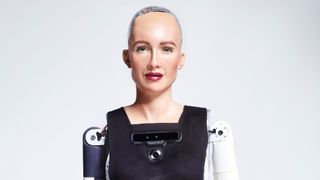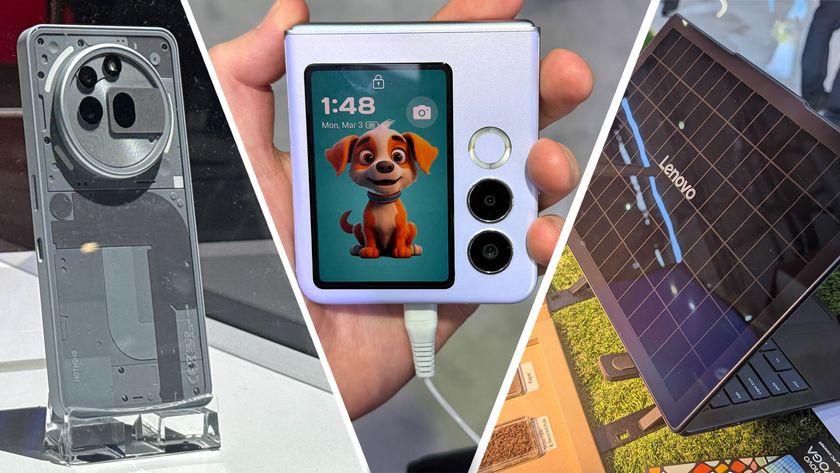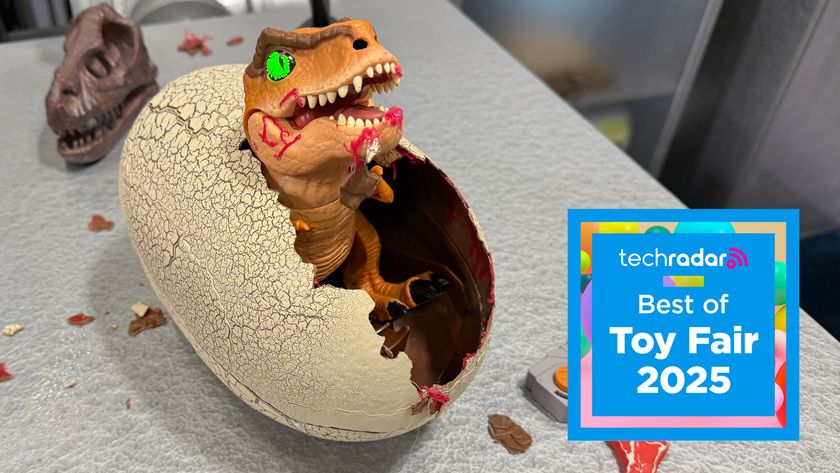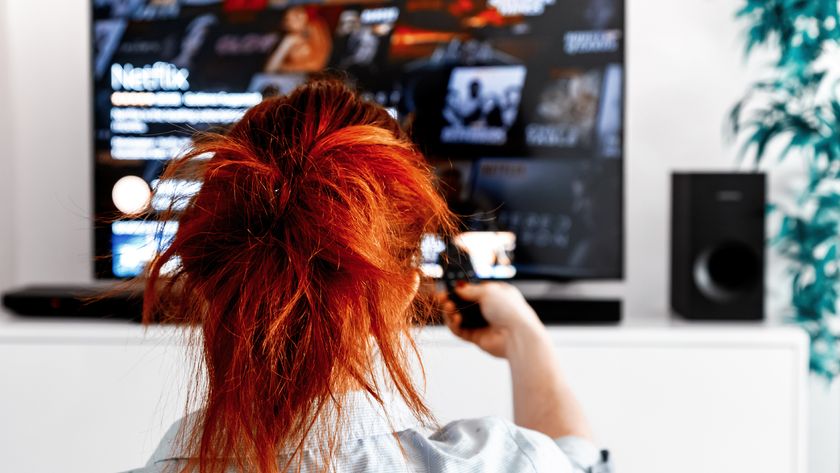Hug me, Dave: are robot pets and companions useful or just sad gimmicks?
Real pets are out, robo-pups are in

At CES 2019 there were plenty of robots on show, including the bread-baking BreadBot, the laundry folding Foldimate, the robo-retail assistant, the Samsung Bot Retail, and of course Hanson Robotics’ lifelike, but undeniably creepy, Sophia.
AI-powered technology and robotics are fueling innovations across a range of industries – and producing more robots than ever before. But are these robots just flashy gimmicks or will they really prove useful in the future?
Although clickbait headlines would have us believe we’re only a few years away from creating robots that could take our jobs, destroy our relationships and take over the world, the robots of the future could be the answer to providing companionship, assistance and emotional connection for those who need it most.
Meet the new breed of robots that just want to be loved – and love you in return.
Carebots, home robots and robo-pets
It’s early days for robots that want to make sure you’re okay, receive hugs and help you around the house, which means there’s no catch-all term for them.
We’ve seen some companies refer to them as companion robots, care bots, robot pets and just, well, cute robots. In research settings they’re also referred to as socially assistive robot technology (SAR) or mobile robotic telepresence (MRT), depending on what they’re built for.
They do a variety of things. Some are designed to follow your face around the room and sustain eye contact, some want to help you move and get around and others use sensors, facial expressions and even generate heat in an attempt to make you feel more connected and cared for.
Get daily insight, inspiration and deals in your inbox
Sign up for breaking news, reviews, opinion, top tech deals, and more.
But the one thing they have in common is that they supposedly have your wellbeing at the forefront of everything they do. At CES 2019 there were lots of new care bots and home bots on display – as well as a few familiar, old faces:
Sony Aibo

Sony’s cute robo-pup Aibo may have been on show last year, but it had a big presence at this year’s CES show too, proving a cute puppy is what Sony thinks we want from a home robot.
Running on a Qualcomm Snapdragon 840 and Amazon’s cloud-based AWS server, Aibo can memorize up to 100 faces and learn an endless stream of new tricks.
- Read our hands on review of the Sony Aibo
Zoetic Kiki

The Zoetic Kiki is a robot pet that’s built to identify faces, which it then follows around the room. It has a lot of different facial expressions that it shows through two big eyes on its screen, as well as touch sensors so it knows when it’s being stroked. According to Zoetic, if you pay attention to Kiki “it will love you more”.
Groove X Lovot

One of the most interesting connection bots of CES 2019 was Lovot from Groove X. This penguin-like character has one mission in life: to make you happy. It has big eyes, it’s teddy bear soft and it moves its wing-like arms when it wants to be hugged. Sensors mean it can move around and not bump into things and its on-board camera recognizes you and makes eye contact.
Groove X says that Lovot is designed to “nurture people’s capacity to love” by requiring touch and affection. It can fall ‘asleep’ if you’ve given it a good hug and radiates heat, it sometimes sulks and begs to be picked up, and if you tickle it, it does a little dance. Oh, and if you didn’t already work it out, Lovot comes from Love + Robot. Aw.
Bocco Emo

Created by Yukai, the Bocco Emo can read messages and responds to them with emotions - by glowing certain colors. It can also detect vibrations, locks, motion, temperature and humidity, making it ideal for children or elderly relatives.
This new model was on show at CES 2019, but its older, original model was first showcased at CES 2015 and has since been used in Japan to help care for elderly people.
Codi

Created by Pillar Learning, Codi is a bit different because it’s a super cute robot created specifically for children, providing them with voice and touch interactions, developmental support and customized content, featuring songs and different lessons.
Codi incorporates a real, highly expressive voice with visual cues to keep children engaged and entertained while they’re learning.
Meet Paro – a seal that likes cuddles

Although there were lots of these wellbeing robots at CES 2019, they’re not new.
One of the most widely-reported examples is Paro, a robot that’s been on the scene since 2004. Described as a therapeutic robot, Paro has been made to look like a cute and fluffy baby seal – and it sounds like one too.
It was designed for those with dementia and learning difficulties, as well as those suffering from social isolation. It uses AI to respond to its name, learn from its surroundings, make noises and move.
Its behavior is intended to promote social interaction, improve mood and much more, and although Paro may seem ancient at 15-years old (in robotics terms, at least), its longevity means there's been plenty of chance to study its efficacy.
There have been numerous studies focused on Paro, but one of the most interesting comes from the University of Brighton. For those with dementia, spending time with Paro was found to reduce agitation and aggression, promote fluency in speech and it worked well to reduce stress as a transition object when family members had to leave.
Robots for a lonely, aging population
Although the findings from Paro are positive, they’re not the only ones, with countless studies in recent years aiming to better understand whether different kinds of robots can help those in need – whether that’s the elderly, those with dementia, disabled people and those who are lonely, depressed or isolated.
Of course it’s not just emotional well-being that robots could help with, but providing real, everyday physical assistance.
A 2017 review of the use of robots in care settings found that they have a range of positive effects in all kinds of settings and can effectively act as a companion and social facilitator. But they can also help with cognitive training, affective therapy and physiological therapy.

But why do we need robots when we have other humans to care for us? Well, with the elderly population set to more than double by 2050, reaching a total global population of 2.1 billion compared with 901 million in 2015, robots might be the answer to making sure everyone gets the proper level of care they need.
It’s the same answer for other social issues too. Loneliness and social isolation can be big predictors in declining health and even early death. For those people, a robot companion that’s proven to soothe, ease stress and promote wellbeing could be life-changing.
Of course, in an ideal world, we would all receive a high level of specialized care and ongoing connection from other humans. But there are many reasons why that isn’t always the case - and many more reasons why it could become even more of a problem in the future given resources are already stretched thin and social care is very labour intensive.
So although we’re not suggesting that we replace humans with robots, the reality could be more nuanced. Human interaction may be preferred, but for many care, connection and support from a robot might be a more viable way of being looked after and providing a much-needed source of companionship and connection.

The importance of creating cuteness
Of course one of the biggest barriers to creating a whole legion of robots to care for us is that people might not feel so comfortable having them in their homes.
Stats from Pew Research in 2017 show that 70% of those in the US are wary about robots carrying out tasks currently carried out by humans. This belief could be down to lack of knowledge or the influence of clickbait headlines and sci-fi movies.
Of course that’s not to say there isn’t reason to be concerned. After all, if robots are going to become as important as pets, care assistants or even another member of the family, they need to be created with a whole host of ethical, psychological and social considerations from the get go.
But assuming they’re going to be safe for us and others around us, how do we ensure robots make people feel comfortable enough to start hugging one? Well, that’s where the cuteness factor comes in.
As more and more robots are created, we’re beginning to get a better sense of which of them make us feel comfortable and which make us feel creeped out.
That’s where the term ‘Uncanny Valley’ comes in. It’s used to describe that space between robots that look very obviously like robots and robots that look exactly like humans - somewhere in the middle, our brains kick in and feel very unnerved by what we have seen, which is maybe the reason many of us recoil a little every time we see Sophia.

For robots designed to comfort and be cared for, the current design solution isn’t to create a full humanoid robot that could elicit those feelings, but instead create one that looks, acts, and even feels more like a pet with some human-like qualities.
That’s why a lot of their bodies look like little futuristic pets, but a lot of their expressions look like ours. One study found that people are more likely to have empathy for a robot if its expressions mimic their own.
A whole host of operational and design considerations go into how these robots look, based on the assumption that people are more likely to trust and feel safe among these robot companions if they look familiar and affectionate.
Research has shown that it’s not just looks that play a part too, but their stories and personalities. A 2015 study found people had more empathy with robots that had a story - meaning the cute naming strategy of the Aibo, the Lovot and all the rest serves a very real purpose.
Robots could be key in providing care
In a world filled with sci-fi notions of what robots could soon be like, as well as advances in robots that look more real than ever, it’s easy to look at Paro the Seal or Lovot and think they’re just toys or souped-up Furbies.
But the population is aging, people are lonely and many can’t get access to the care they need. Although many of these robots are still in the early stages and may not make it to our homes for years - if at all - they could play an important role in the future of care and connection.
Built to prevent loneliness and provide various levels of care, these robots don’t have to be a replacement for human contact. For many, they could just be about keeping people open to love and connection during difficult or isolating times.
So maybe the AI-filled future won’t be full of robots taking our jobs or android brothels like the tabloids would have us believe. Instead maybe there’s huge potential for robots to be our carers, our pets and even our friends?
Becca is a contributor to TechRadar, a freelance journalist and author. She’s been writing about consumer tech and popular science for more than ten years, covering all kinds of topics, including why robots have eyes and whether we’ll experience the overview effect one day. She’s particularly interested in VR/AR, wearables, digital health, space tech and chatting to experts and academics about the future. She’s contributed to TechRadar, T3, Wired, New Scientist, The Guardian, Inverse and many more. Her first book, Screen Time, came out in January 2021 with Bonnier Books. She loves science-fiction, brutalist architecture, and spending too much time floating through space in virtual reality.



















